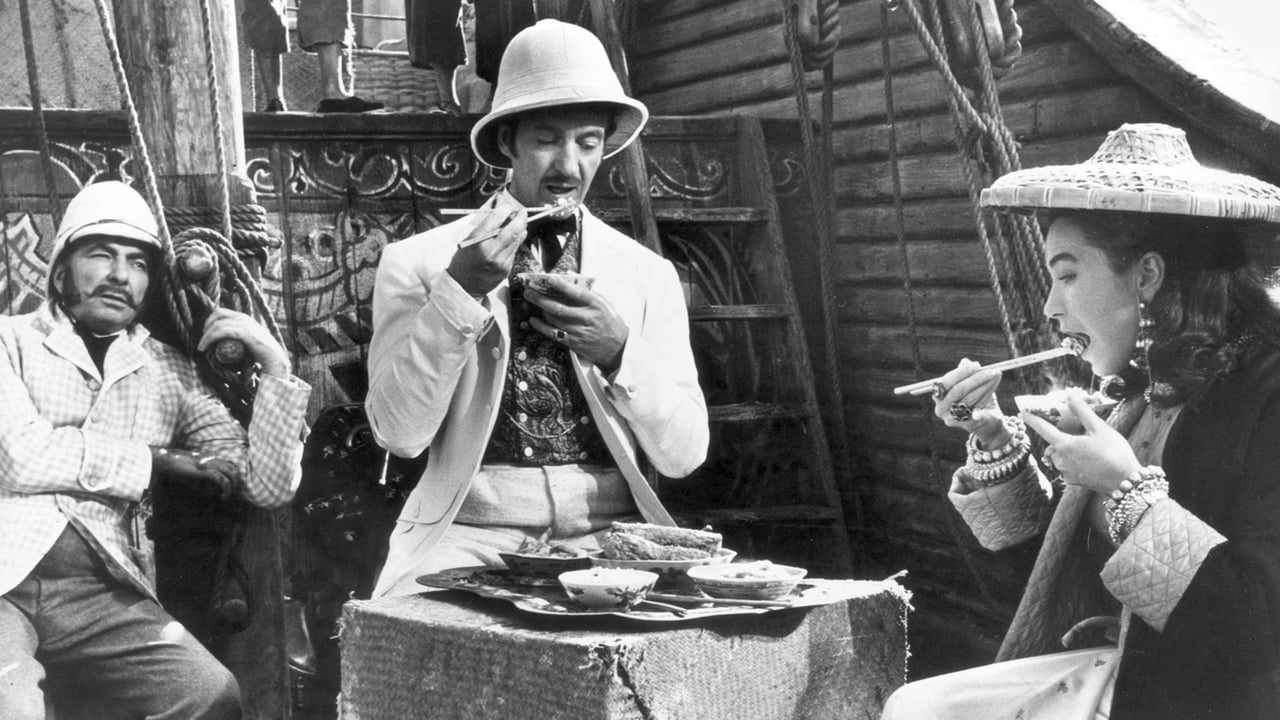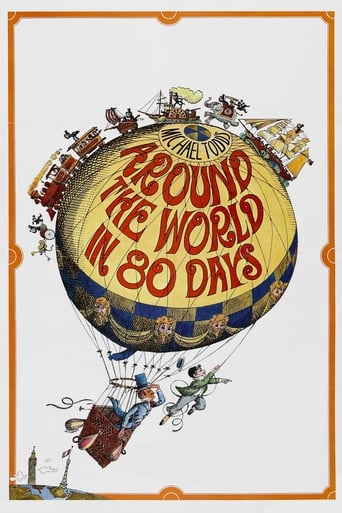

My grandfather told me he did not see this film at a younger age when it came out because it would be stupid. Probably a musical with dumb songs and just a fleeting glance at old stars that no one cared about any more. Then I saw it recently and it is none of the above. Perhaps it"s because I am older now and love to watch old movies on TCM.. I mean back to the 20's through the fifties---and on---and I know most of these actors in cameo appearances.I am sure a Millenial would think a movie from the 80's to be very old, and a Gen Xer a movie from the 60's or 70's the same. And this is being generous. Perhaps also I discovered that I love David Niven as an actor. It was this movie that got me to appreciate him. I bought his autobiography and a biography on him as a result. Now onto the film itself. I thought Contanflas would simply be clownish in his acting, but he played his comedy straight. He was excellent. I agree that Shirley McClain was a poor choice as a Princess from India. This was ridiculous. But she did not ruin the movie. She was perhaps a 1/2 star off the rating tho. She was just wrong for the part. Now as to the story. It was a joy to see that there was an Intermission. Films now have no Intermissions even if they are 3 hours long. It is great that TCM shows the entire movie unaltered. So I ask you to look at it as a iight comedy with excellent acting and I think you will enjoy it. It is extremely colorful and yes, should be seen in widescreen. It is funny, my grandfather recalled, that when he was a boy it cost $2000 or more to fly from Chicago to Los Angeles. Today, this flight could cost 100 bucks! Therefore more people of the 50's would have been more interested in seeing the actual scenes from around the globe than this generation. This was mentioned by another reviewer. Still, it is a Jules Verne book. It is a futuristic book and must be approached as such. We do so with other books/movies such as 1984, released in 1949, and ATWIn80Days was released in 1873 and is set in 1872. I have deducted 1/2 star for Shirley McClain, who I otherwise think is a fine actress, and 1/2 point for the travel scenes which do tend to elongate the movie and not enhance the plot. But I don't think that is a big deal overall. Great Film!
... View MoreAs a kid I really enjoyed Michael Anderson's Around the World in Eighty Days, it looked spectacular fun with a lot of stars popping in.Watching the film some years later, it really is an overlong mess and the silliness is hard to overlook.The film however does look gorgeous, it is beautifully photographed, filled with countless star cameos, many of them who are now forgotten. The film is helped by some wonderful location shooting, this is certainly not just the Universal back-lotDavid Niven is effortless as Phileas Fogg who has to circumnavigate the world in 80 days in order to win a wager. Cantinflas is just OK as his servant and comic relief, Passepartout who seems to constantly slow Fogg down with his overlong routines such as the bullfight in Spain that just goes on and on.
... View MoreMichael Anderson's film is justifiably memorable for its huge cast, its memorable photography (by Lionel Linden), its catchy theme tune (Victor Young), and its sheer brio. It remains producer Mike Todd's crowning achievement, a lasting legacy for a showman whose life was brutally curtailed by an air-crash in 1958. The epic is held together by two memorable performances from David Niven as Phileas Fogg and Cantinflas as his loyal servant Passepartout.Structurally speaking, however, AROUND THE WORLD IN EIGHTY DAYS is a mess. There are some memorable individual sequences - for example, at the beginning when Fogg makes a bet in London's Reform Club with his fellow-members (Finlay Currie, Ronald Squire, Trevor Howard, Basil Sydney); or the brief exchange at the domestic services agency involving Fogg's former manservant (John Gielgud) and the proprietor (Noel Coward). Later on Fogg has a memorable exchange with the Indian Peninsular Railway Official (Ronald Colman), in which the two actors compete for who can speak their lines in the best RP (Received Pronunciation) accent. Once Fogg crosses to the United States, he has another memorable encounter with a Barbary Coast saloon pianist (Frank Sinatra).Yet such sequences are often separated by long stretches of film where nothing really happens: Passepartout has a long bull-fighting sequence, watched by Fogg and Achmed Abdullah (Gilbert Roland), that becomes tedious; likewise the funeral sequence where Fogg saves Princess Aouda (Shirley MacLaine) from death seems to be included simply to show off director Anderson's love of local color. In the end the experience of watching the film becomes an exercise in identifying the stars playing cameo roles - for a film buff of the mid-twentieth century, this can be a fascinating experience, but perhaps not to most viewers' taste. Nonetheless, it's fun to see actors such as Robert Newton, Joe E. Brown, Peter Lorre, John Carradine, John Mills, Glynis Johns, Hermione Gingold and even Buster Keaton in cameo roles. If you blink too much, you might miss them.David Niven doesn't have too much to do in this film, other than to reinvent his familiar screen persona as an urbane man-about-town, perpetually faced with the responsibility of taming his manservant's excesses. Nonetheless he does his task competently.AROUND THE WORLD IN EIGHTY DAYS is an exhausting experience to watch, but one that still communicates incidental pleasures, especially to viewers from an older generation.
... View MoreNot bad. Had the potential to be frightfully boring, especially considering its 3-hour running time. The plot is quite conventional, and feels reasonably padded. Also can be a bit mundane if you already know the story (and who doesn't).However, it was fairly entertaining. Made so mostly by the scenery and excellent cinematography. Felt like a travel documentary.The occasional humour also helps.Performances are nothing to write home about. David Niven is overly stuffy as Phileas Fogg. (But that's all he knows how to do). Supporting cast have a host of big names in minor, sometimes very fleeting roles: Noel Coward, Sir John Gielgud, Trevor Howard, Frank Sinatra, Marlene Dietrich, John Carradine, Buster Keaton.Certainly didn't deserve a Best Picture Oscar, but not that bad.
... View More